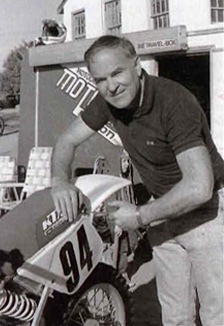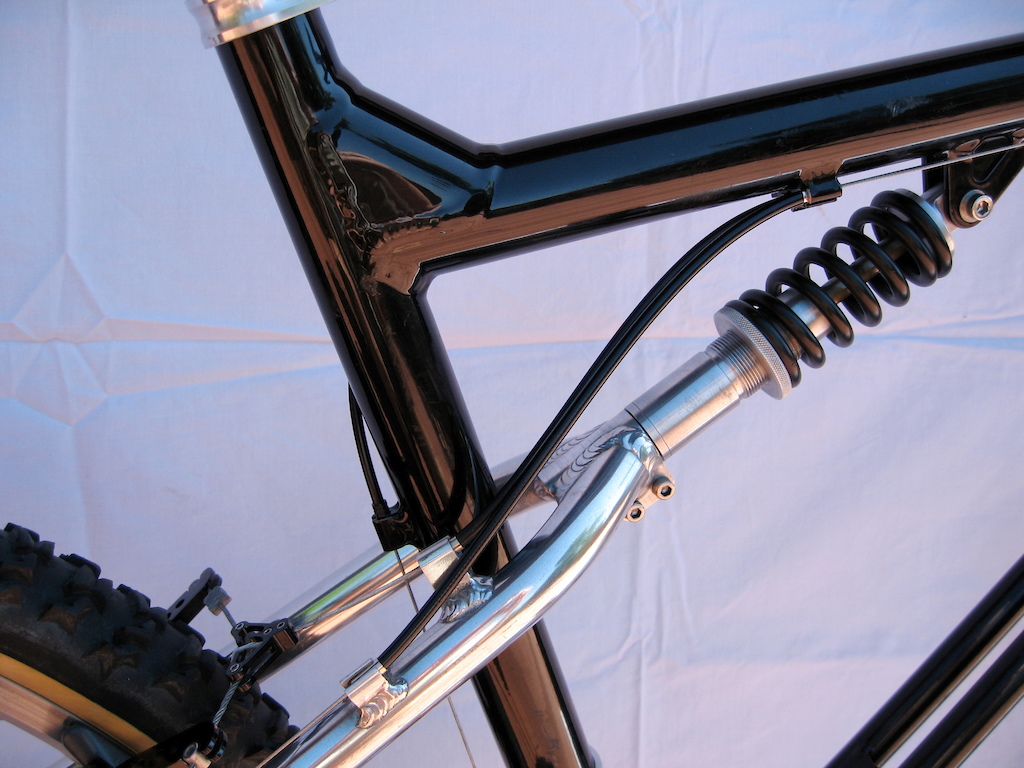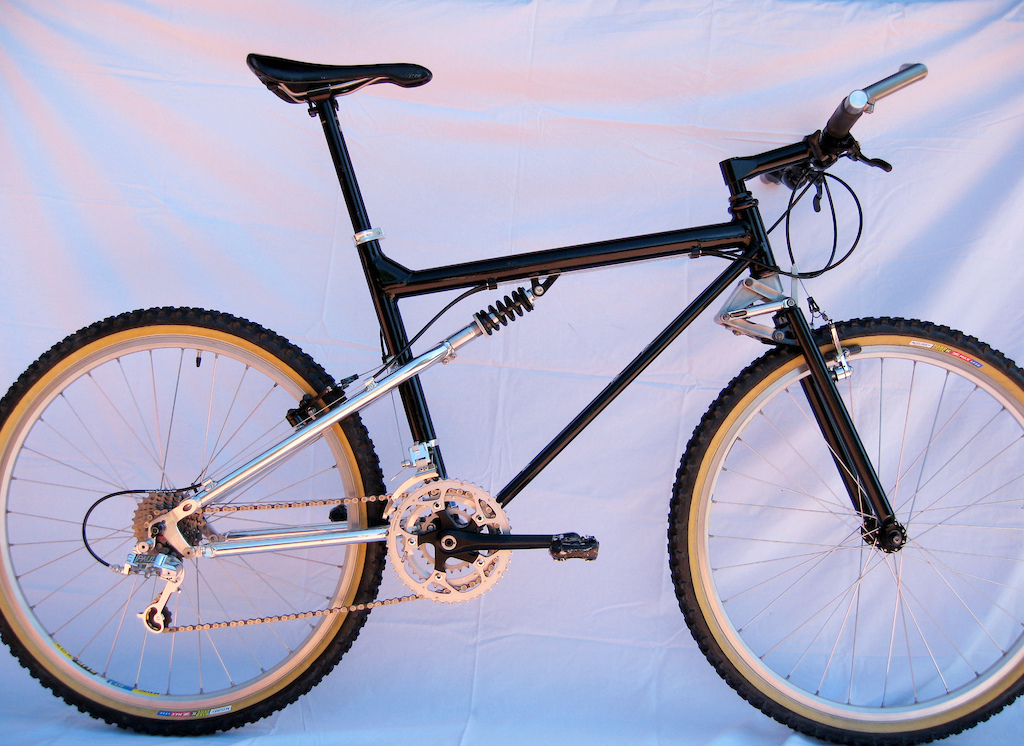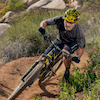Now THAT Was a Bike: 1993 AMP Research B2

This story begins with Horst Leitner, a young engineer and motocross racer who left his home in Austria to set up shop in the Unites States. He founded AMP Research and among his many endeavors, he invented a motorcycle rear suspension that removed braking and acceleration torque from the suspension action, which led him to design and manufacture ATK motorcycles in the 1980s - one of the first competitive four-stroke motocross racing bikes.
Most of us, however, know of him in reference to the "Horst Link" dropout, which is ubiquitous today, but was an important invention in the early 1990s, when dual-suspension mountain bikes were in their infancy.
By 1993, Horst Leitner was still racing motocross every week, but his new passion was riding mountain bikes on the trails near his Laguna Beach home. It didn't take long for the inventor to come up with an
improved mountain bike. Initially, Horst developed a simple rear suspension for Specialized, and it marked the brand's entry into the dual-suspension arena - well, kind of.
Leitner was convinced that rear suspension was going to revolutionize the sport, and quickly became frustrated with the boys at Specialized, who, in his words, "Seemed like they wanted to make a suspension bike, but were screwing around and going nowhere." Patience is not one of Leitner's virtues, so before long, he had assembled a small factory that began churning out aluminum-framed dual-suspension bikes, the likes of which, the bicycle industry had never seen before.
Leitner was convinced that rear suspension was going to revolutionize the sport, and quickly became frustrated with the boys at Specialized, who, in his words, "Seemed like they wanted to make a suspension bike, but were screwing around and going nowhere." Patience is not one of Leitner's virtues, so before long, he had assembled a small factory that began churning out aluminum-framed dual-suspension bikes, the likes of which, the bicycle industry had never seen before.
AMP B2 1993:
• Use: cross-country / trail
• Aluminum double down tube frame, 4-bar suspension, 3" travel
• AMP F1 linkage fork, aluminum upper, chromoly lowers, 2.5" travel
• AMP through-shaft hydraulic coil-shocks, front and rear
• Head angle: 71 degree, Seat angle: 73
• Brakes: cable-actuated cantilever
• Sizes: Small, medium, large
• Manufactured in Laguna Beach, California
• Use: cross-country / trail
• Aluminum double down tube frame, 4-bar suspension, 3" travel
• AMP F1 linkage fork, aluminum upper, chromoly lowers, 2.5" travel
• AMP through-shaft hydraulic coil-shocks, front and rear
• Head angle: 71 degree, Seat angle: 73
• Brakes: cable-actuated cantilever
• Sizes: Small, medium, large
• Manufactured in Laguna Beach, California

Horst Link: Leitner facilitated the creation of a successful four-bar rear suspension by moving the seat stay pivot from its traditional place above the dropout, to a position significantly below and in front of the rear axle. Vintage Mountain Bike Workshop photo
The model B2 featured here was Leitner's first production model and a benchmark for light weight and simplicity. Its seat stays drove the shock directly and were not laterally supported by a rocker link. To facilitate this suspension configuration, Horst designed a hydraulic through-shaft damper that mounted directly to the seat stay strut. With a bushing on either end of the shock shaft, the damper could handle lateral stress without self-destructing like a traditional shock would.

Theoretically, there was no need for a pressurized IFP piston inside AMP's through-shaft shock, because the fluid volume remained constant. In reality, the shock always had a little air inside and the hissing sound it made during the rebound stroke was called "AMPhysemia." Vintage Mountain Bike Workshop photo
His compact F1 linkage fork is still a bit of a marvel today. Horst designed it to emulate the axle path of a telescopic fork, while keeping all the moving bits up top, so he could still use cable-operated rim-brakes. The fork was suspended by a stiff steel spring tucked under steerer tube, while damping was handled by a pair of impossibly small through-shaft shocks, pinned to the sides of the linkage arms.

AMP's minimalist four-bar linkage fork design was intended to be a lightweight cross-country design that could compete against equally spindly 50-millimeter-stroke telescopic forks from Manitou and RockShox.
Leitner had no problem with bucking tradition or arguing with unsympathetic press. His made-in-the USA ATK motorcycles had polarized both the media and top motocross racers against his off-center engineering solutions and alternative suspension concepts.
After weathering that storm, Leitner was unfettered by a fresh-faced mountain bike industry infatuated by cross-country racing and titanium hardtails, whose illuminati preached that rear suspension was a laughable folly. He aimed for the heart - to create a dual-suspension XC bike that could prove them wrong.
His engineering approach was unique in that he took nothing for granted. Simplicity was his religion. He challenged every aspect of traditional design to discover a better solution or a more effective way to manufacture it. For example: in place of a conventional shim stack and a mechanically-valved damping piston, his shock damping circuit used a $1.25 square-seal that shuffled back and forth over a series of holes to control rebound and compression flow.
After weathering that storm, Leitner was unfettered by a fresh-faced mountain bike industry infatuated by cross-country racing and titanium hardtails, whose illuminati preached that rear suspension was a laughable folly. He aimed for the heart - to create a dual-suspension XC bike that could prove them wrong.
His engineering approach was unique in that he took nothing for granted. Simplicity was his religion. He challenged every aspect of traditional design to discover a better solution or a more effective way to manufacture it. For example: in place of a conventional shim stack and a mechanically-valved damping piston, his shock damping circuit used a $1.25 square-seal that shuffled back and forth over a series of holes to control rebound and compression flow.
The Build:
Stem: Ringle Zooka Quill
Headset: Chris King Threaded
Bottom Bracket: Shimano Cartridge Bearing
Handlebar: Answer Hyperlite
Shifters: Shimano XTR M900 w/ Grafton Perches
Front Derailleur: Paul 409
Rear Derailleur: Paul Power Glide
Brakes: Grafton Re-Entry levers, Speed Control cantilevers
Crankset: Grafton Speed Sticks, Shimano XTR 26=36-46t
Pedals: Shimano XT 737
Wheels: Ringle Super Bubba hubs, Mavic 217 rims
Tires: Ritchey Z-Max Hard Drive 1.95
QR: American Classic
Seatpost: Ringle Moby
Saddle: Selle Italia Flite
Grips: Scott AT
Cogs: SRP Titanium 7-speed
Bar-ends: Titanium (from Dave Wiens)
Stem: Ringle Zooka Quill
Headset: Chris King Threaded
Bottom Bracket: Shimano Cartridge Bearing
Handlebar: Answer Hyperlite
Shifters: Shimano XTR M900 w/ Grafton Perches
Front Derailleur: Paul 409
Rear Derailleur: Paul Power Glide
Brakes: Grafton Re-Entry levers, Speed Control cantilevers
Crankset: Grafton Speed Sticks, Shimano XTR 26=36-46t
Pedals: Shimano XT 737
Wheels: Ringle Super Bubba hubs, Mavic 217 rims
Tires: Ritchey Z-Max Hard Drive 1.95
QR: American Classic
Seatpost: Ringle Moby
Saddle: Selle Italia Flite
Grips: Scott AT
Cogs: SRP Titanium 7-speed
Bar-ends: Titanium (from Dave Wiens)

Like many rear-suspension designs, AMP's B2 did not play well with cantilever rim brakes of the time. The off-angle cable pull eroded braking power, and soon-after, Leitner would develop his own disc brake system to put that issue to bed.
Horst's approach to creating the lightest possible bicycle was to begin with prototypes that were intentionally too weak to survive and then reinforce each aspect that failed during testing until the product evolved to its optimum strength-to-weight ratio. To that end, the B2 was crazy light for its time. At 23 pounds, it rivaled elite-level rigid XC bikes. Leitner's quest for the lightest possible suspension bike, however, would eventually become a liability.
The B2, with its F1 linkage fork, its twin down tubes, simple rear-suspension profile and bare-aluminum finish, was a complete concept at a time when most suspension designs still appeared to be college science projects. They handled well, and as advertised, the suspension did its job without interfering with the rider's pedaling action. When pushed hard, however, the B2 was too fragile to hold up under aggressive trail riders, and it was too flexible to convert pro-level cross country types over to the dark side.
The legacy of the B2 was living proof that it was possible to build a dual-suspension mountain bike at a competitive weight and with comparable pedaling performance of the generic '90s era hardtails. Horst continued to progress the design. Successive models had additional travel, linkage-driven shocks, bolt-on seat masts, and improved shock technology. Horst also developed an ingenious bonding technique, used to assemble both aluminum and carbon fiber sub-frames, many of which were sold under the Mercedes brand.

The B2 was the first lasting blow dealt to the cross-country hardtail and an example of the level of ingenuity that would be necessary for future designers to bring the dual-suspension mountain bike to where it is today. Ultimately, Horst Leitner's aptitude for invention and his courageous insistence to manufacture every key component turned out to be the downfall of the B-series bikes. Stranded without a source for replacement parts, relatively few rideable examples survive today.
Special thanks to the Vintage Mountain Bike Workshop, AMP Research and Motocross Action Magazine for archival images.
Author Info:
Must Read This Week
Sign Up for the Pinkbike Newsletter - All the Biggest, Most Interesting Stories in your Inbox
PB Newsletter Signup


 Member since Mar 23, 2011
Member since Mar 23, 2011
G's up, ho's down.
Signed,
Bill C.
Broke the frame twice, backend was super flexy, had Judy DH & HS33 race lines, steep stem and risers on it.
Restored it recently with all 93 parts (Chris King, Cook, Trialgins, Real, XTR M900, Control Tech, Flite Gripshift...),
and now using it for bike packing (gravel roads), it is perfect for this purpose (3 bottle cages and 50mm travel front & rear).
I was so happy with it, that I also bought and rebuilt a 1994 B2 as city racer, 9.9 KGs!
www.pinkbike.com/u/one38/album/AMPs
Specialized
Norco
GT
Cannondale
Rocky Mountain
YT
Canyon
Transition
Felt
Scott
Knolly
Guerrilla Gravity
Cube
Radon
Mongoose
Pretty impressive for a design that was invented 25 years ago!
Went from a Rockhopper to the Amp and whoa! Super plush!
When it's all you know, and it's the best thing going, then at the time you're riding it you're on something special. And special it was. Really light, pivots wore out fast, fork was divey but at the time seemed plush, more plush than the Manitou (disintegrating rubber bumpers!). Of course the whole thing was noodley but I don't think we much cared or even thought about it back then. We just rode our bikes and had fun.
Some of the bikes from the 90's were wild. Bikes like the Karpiel Armageddon, the Brooklyn Machine Works, the Cannondale Fulcrum, etc...some crazy envelope pushing back then. Almost like bike companies were releasing a bike like the Polygon Xquarone every year. Compared to now a days...companies make their rear ends boost 157 from 150 and call it innovation. Maybe the bike has been perfected.
Well, first things first.
The new / radical and wonderful new designs ALWAYS suffer by the fashion nazis (and mostly spoiled brats) of their times. This seem to be an axiom.
To prove my claim, i invite all to check the collective negativity which (always) hits like a tsunami every radical / fresh design of our times, as long as it doesn't look like a....session! Just check the comments under PP article about the Structure Cycleworks new wonder.
Great article, as always Richard. If i may so, i challenge you to investigate and eventually write about this timeless negativity. How the first mountain bikes were mocked by the roadies of that time. how the first FS bikes were rejected by the, then "experts".
And most important,
How this tendency reflects over the mountain bike evolution. New designs have to smooth their way, in order to be visually acceptable.
All in all, the long road of the mountain bikers social evolution!
I rolled out my B5 last year and could barely ride it up the street - The stem was so long and the bike so spindly and sketchy. I can't believe we not only rode big epics but also tacked what we considered gnar on that thing.
The bike wasn't pristine by any means but I still sold it for $700 on ebay, I was surprised by that, even though it was one of the first bikes using carbon in the tubes and lots of other innovative stuff.
The downfall of this design was that the industry shifted from the titanium hardtailed xc racers to North Shore Extreme in the late 90's.
I moved to North Vancouver in 96 and took my Amp forked bike out only once.
While recovering from multiple endos, after being schooled on Mt. Fromme, I was looking elsewhere for longer travel forks.
I still have scars from that ride.(Like real scars from tearing open my leg)
I think this might be part of the reason we didn't hear much from AMP after the late 90's, 3.5" just wasn't enough.
Also, cool story Hansel.
The rear break has a cable attached to the rear triangle. When the rear is compressed the distance between the break base and the rim does not change. But the cable shrinks as the travel between the base of the break and the break lever shortens. Right? that would mean that the breaks would not work at all when compressing the rear. Or am i getting this totally wrong ?
Just got back from riding this morning with a 2017 bike that has, what else, but a Horst link. Things change and yet they stay the same.
In a cross country race on Mount Hood (oregon), he went over minor jump and the fork bottomed out and exploded apart, sending him to the ground. It was RockShox Mag 21 after that. That is about all I remember about that fork.
ANYONE WANNA OWN ONE? you can buy one of mine, Almost as cool as this one and not nearly the price tag..
vancouver.craigslist.ca/nvn/bik/6725335356.html
www.ebay.com/itm/AMP-Research-B4-Mercedes-Benz-Mountain-Bike-Full-Suspension-F3-VINTAGE-Police/263987139010?hash=item3d76dc11c2:g:f5kAAOSwszVbptGj:rk:2:pf:0
What's sad is the fact that despite 25 years passing since it's original design there has been little to no improvement in FS bike designs. Just look at the current crop of 'offerings'. They are mostly all Horst link or 4/faux bar. Engineers have given up on R & D - see ingenuity- and left everything up to the marketing people.
What a joke bicycle design has become. I ain't paying anything near what they want for what basically amounts to copycats of a 25yr old design, and I sure as hell ain't going to pay for the marketing they use to try and make them seem any different.
Congratulations bicycle industry! I will never purchase a new bicycle again.
Thank you Mr. Leitner! For creating such an incredible design that still remains at the top.
BTW: you can count on RC to say the smart thing: the idea that the angle of the rear pulling cable rubbed power from cantilever brakes on suspension bikes is really precious!